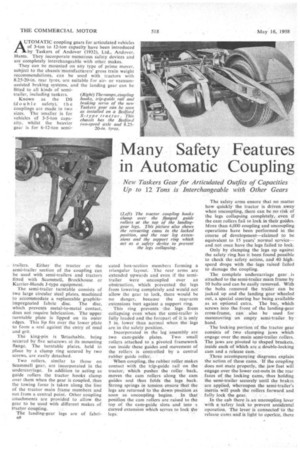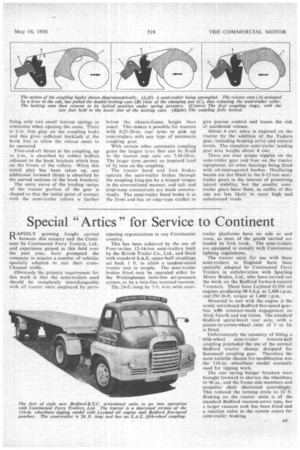Many Safety Features in Automatic Coupling
Page 42

Page 43

If you've noticed an error in this article please click here to report it so we can fix it.
New Taskers Gear for Articulated Outfits of capacities Up to 12 Tons is Interchangeable with Other Gears AUTOMATIC coupling gears for articulated vehicles of 3-ton to I2-ton capacity have been introduced by Taskers of Andover (1932), Ltd., Andover. Hants. They incorporate numerous safety devices and are completely interchangeable with other makes.
They can be mounted on any type of prime mover. subject to the chassis manufacturers' gross train weight recommendations, can be used with tractors with 8.25-20-in, rear tyres, are suitable for airor vacuumassisted braking systems, and the landing gear can he fitted to all kinds of semitrailer, including tankers.
Known as the DS (double safety), the couplings are made in two sizes. The smaller is for vehicles of 3-5-ton capacity, whilst the heavier gear is for 6-12-ton semi trailers. Either the tractor or the semi-trailer section of the coupling can be used with semi-trailers and tractors fitted with Scatnmell, Brockhouse or Karrier-Hands J-type equipment.
The semi-trailer turntable consists of two large circular steel plates, machined to accommodate a replaceable graphiteimpregnated fabric disc. The disc, which prevents metal-to-metal contact, does not require lubrication. The upper turntable plate is lipped on its outer edges. This lip fits over the lower plate to form a seal against the entry of mud and grit.
The king-pin is 'detachable, being secured by five setscrews at its mounting flange. The turntable plates, held in place by a clamp ring secured by two screws, are easily detached.
Two rollers, similar to those on Scarnmell gear, are incorporated in the undercarriage. In addition to acting as guide rollers the tractor hooks clamp over them when the gear is coupled, thus the towing force is taken along the line of the tractor main frame members and not from a central point. Other coupling attachments are provided to allow the gear to be used with different makes of tractor coupling. The landing-gear legs are of fabriot cated box-section members forming a triangular layout. The rear arms are extended upwards and even if the semitrailer Were uncoupled over an obstruction, which prevented the legs from lowering completely and would not allow the gear to lock, there would be no danger, because the rear-arm extensions butt against a support ring.
This ring prevents -the legs from collapsing even when the semi-trailer is fully loaded and the forepart of it is only 5 in. lower than normal when the legs are in the safety position.
Incorporated in the leg assembly are two cam-guide plates. Two small rollers attached to a pivoted framework run inside these guides and movement of the rollers is controlled by a central rubber guide roller.
When coupling, the rubber roller makes contact with the trip-guide rail on the tractor, which pushes the roller back, moves the cam rollers along the cam guides and thus folds the legs back. Strong springs in tension ensure that the legs are returned to The down. position as soon as uncoupling begins. In that position the cam rollers are raised to the top of the cam-guide slots and into a curved extension which serves to lock the legs. The safety arms ensure that no matter how quickly the tractor is driven away when uncoupling, there can be no risk of the legs collapsing completely, even if the cam rollers fail to lock in their guides. More than 4,000 coupling and uncoupling operations have been performed in the course of development—claimed to be equivalent to 15 years' normal service-and not once have the legs failed to lock.
Only by clamping the legs up against the safety ring has it been found possible to check the safety action, and 40 highspeed drops with the legs raised failed to damage the coupling.
The complete undercarriage gear is attached to the semi-trailer main frame by 10 bolts and can be easily removed. With the bolts removed the trailer can he jacked up and the landing gear wheeled out, a special steering bar being available as an optional extra. The bar, which screws into the front of the landing-gear cross-frame, can also be used for manceuvring an empty semi-trailer by hand.
The locking portion of the tractor gear consists of two clamping jaws which engage over the main semi-trailer rollers. The jaws are pivoted to shaped brackets, inside each of which are a double-locking cam and a release cam.
Three accompanying diagrams explain the action of these cams. If the coupling does not mate properly, the jaw feet will engage over the lower cut-outs in the rear faces of the locking cams, thus holding the semi-trailer securely until the brakes are applied, whereupon the semi-trailer's inertia will push the rollers forward and fully lock the gear.
In the cab there is--an uncoupling lever with a safety lock to prevent accidental operation. The lever is connected-to the release cams and is light to operhte, there
being only two smalL tension springs to overcome when opening the cams. There is Fin, free play on the coupling locks and this gives sufficient backlash at the hook feet to allow the release earns to be operated.
Fore-and-aft thrust at the coupling, up
to is absorbed by rubber buffers adjacent to the hook brackets which bear on the fronts of the rollers. When this initial play has been taken up, arty additional forward thrust is absorbed by the curved sections of the hook brackets.
The entry curve of the loading ramps of the tractor portion of the gear is shaped so that the initial point of contact with the semi-trailer rollers is further below the chassis-frame height than usual. This makes it possible for tractors with 8.25-20-in, rear tyres to pick up semi-trailers with any type of automatic coupling gear.
With certain other automatic coupling gears the largest tyres that can be fitted to the tractor rear .axle are 7.50-20-in. The larger tyres Permit an imposed load of 5:1, tons on the coupling.
The tractor hand and foot brakes operate the semi-trailer brakes through the coupling king-pin by a hinged tongue in the conventional manner, and tailand stop-lamp connections are made automatically. The semi-trailer h'and brake is at the front and has an edge-type ratchet to give precise control and lessen the risk of accidental release.
About 4 cwt, extra is imposed on the tractor by the addition of the Taskers gear, including braking servo and control levers. The complete semi-trailer landing year also weighs about 4 cwt.
There are nine nease nipples on the semi-trailer gear and four on the tractor equipment, all other bearings being fitted with oil-inipregnated bushes. Oscillating beams are not fitted to the 6-12-ton semitrailer gears in the interest of preserving lateral stability, but the smaller serriitrailer gears have them, as outfits of this size arc less likely to carry high. and unbalanced loads.




































































































